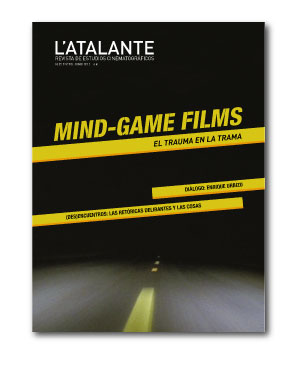Notebook
Published 2013-01-01
Keywords
- Gag,
- narrative,
- game,
- Buñuel,
- film
- repetition,
- interruption,
- difference ...More
How to Cite
Garin Boronat, M. (2013). Running Bombs. The visual gag, Buñuel and the limits of narration. L’Atalante. Journal of Film Studies, (15), 58–65. https://doi.org/10.63700/43
Abstract
The visual gag is one of those gameplay elements, powerful and ambiguous, which question the value of narrative by constructing and destructing at the same time. This text draws upon a number of ideas focused on the relation between mind game films and gags, studying images that problematize the sense of storytelling through interruption, repetition and difference. A brief genealogy of Hollywood’s running gags prologues the analysis of several Luis Buñuel’s examples, which foster narrative ambiguity using gags that render laugh but disturb us even more. Finally, a case study of the sack gag in That Obscure Object of Desire proves the ability of sight gags in order to narrate without narrative, paradoxically.Downloads
Download data is not yet available.
References
AUERBACH, Erich (2002). Mímesis. México: Fondo de Cultura Económica.
BAUDELAIRE, Charles (1989). Lo cómico y la caricatura. Madrid: Visor.
BLOOM, Harold (2001). El canon occidental. Barcelona: Anagrama.
BORDWELL, David y THOMPSON, Kristin (1993). El arte cinematográfico. Barcelona: Paidós.
BUÑUEL, Luis (1983). Mi último suspiro. Barcelona: Plaza y Janés.
BUÑUEL, Luis (1972). Contra toda infección sentimental. En J. L. GUARNER y J. OLIVER (ed.), Buster Keaton contra la infección sentimental (pp. 33-35). Barcelona: Anagrama.
CAVELL, Stanley (1999). La búsqueda de la felicidad. Barcelona: Paidós.
CRAFTON, Donald (1995). Pie and Chase: Gag, Spectacle and Narrative in Slapstick Comedy.
CUÉLLAR, Carlos (1998). El mecanismo mágico: definición y descripción del ‘gag’ cinematográfico. Semiosfera nº8.
BRUNOVSKA, K. y JENKINS, H. (ed.)(1995), Classical Hollywood Comedy (pp. 106-119). New York: Routledge.
DELEUZE, Gilles (2002). Diferencia y repetición. Buenos Aires: Amorrortu.
DELEUZE, Gilles (2003). La imagen-movimiento. Barcelona: Paidós.
ELSAESSER, Thomas (2009). The Mind-Game Film. En W. BUCKLAND (ed.), Puzzle Films. Complex Storytelling in Contemporary Cinema (pp. 13-41). Oxford: Wiley-Blackwell.
FRYE, Northrop (1991). Anatomía de la crítica. Caracas: Monte Ávila Editores.
GUNNING, Tom (1995). Crazy Machines in the Garden of Forking Paths: Mischief Gags and the Origins of American Film Comedy. En K. BRUNOVSKA y H. JENKINS (ed.), Classical Hollywood Comedy (pp. 87-105). New York: Routledge.
LYON, Elisabeth (1973). Luis Buñuel: The Proccess of Dissociation in Three Films. Cinema Journal, 13, 1.
MARS, François (1964). Le gag. Paris: Editions du Cerf.
MONTIEL, Alejandro (2005). Ad Lumina: breve oceanografía del humorismo. En PAVÍA, J. El cuerpo y el comediante. Valencia: Universidad Politécnica.
NEALE, Steve y KRUTNIK, Frank (2003). The Case of Silent Slapstick. En KRUTNIK, F. (ed.), Hollywood Comedians. The Film Reader (pp. 57-72). London: Routledge.
PASQUIER, Sylvain Du (1972). Los gags de Buster Keaton. En C. METZ (ed.), Análisis de las imágenes (pp. 164-181). Buenos Aires: Tiempo Contemporáneo.
POYATO, Pedro (2011). Suspensión del sentido y repetición en El ángel exterminador. Fotocinema, 3, 3-16.
RUSSELL, Dominique (2009). Buñuel: the gag, the auteur. Canadian Journal of Film Studies, 18, 2.
STURGES, Preston (1990). Preston Sturges by Preston Sturges. New York: Simon & Schuster.
TORRENTE BALLESTER, Gonzalo (2004). El Quijote como juego. Barcelona: Destino.
TWAIN, Mark (2007). Las aventuras de Huckleberry Finn. Barcelona: De Bolsillo.
BAUDELAIRE, Charles (1989). Lo cómico y la caricatura. Madrid: Visor.
BLOOM, Harold (2001). El canon occidental. Barcelona: Anagrama.
BORDWELL, David y THOMPSON, Kristin (1993). El arte cinematográfico. Barcelona: Paidós.
BUÑUEL, Luis (1983). Mi último suspiro. Barcelona: Plaza y Janés.
BUÑUEL, Luis (1972). Contra toda infección sentimental. En J. L. GUARNER y J. OLIVER (ed.), Buster Keaton contra la infección sentimental (pp. 33-35). Barcelona: Anagrama.
CAVELL, Stanley (1999). La búsqueda de la felicidad. Barcelona: Paidós.
CRAFTON, Donald (1995). Pie and Chase: Gag, Spectacle and Narrative in Slapstick Comedy.
CUÉLLAR, Carlos (1998). El mecanismo mágico: definición y descripción del ‘gag’ cinematográfico. Semiosfera nº8.
BRUNOVSKA, K. y JENKINS, H. (ed.)(1995), Classical Hollywood Comedy (pp. 106-119). New York: Routledge.
DELEUZE, Gilles (2002). Diferencia y repetición. Buenos Aires: Amorrortu.
DELEUZE, Gilles (2003). La imagen-movimiento. Barcelona: Paidós.
ELSAESSER, Thomas (2009). The Mind-Game Film. En W. BUCKLAND (ed.), Puzzle Films. Complex Storytelling in Contemporary Cinema (pp. 13-41). Oxford: Wiley-Blackwell.
FRYE, Northrop (1991). Anatomía de la crítica. Caracas: Monte Ávila Editores.
GUNNING, Tom (1995). Crazy Machines in the Garden of Forking Paths: Mischief Gags and the Origins of American Film Comedy. En K. BRUNOVSKA y H. JENKINS (ed.), Classical Hollywood Comedy (pp. 87-105). New York: Routledge.
LYON, Elisabeth (1973). Luis Buñuel: The Proccess of Dissociation in Three Films. Cinema Journal, 13, 1.
MARS, François (1964). Le gag. Paris: Editions du Cerf.
MONTIEL, Alejandro (2005). Ad Lumina: breve oceanografía del humorismo. En PAVÍA, J. El cuerpo y el comediante. Valencia: Universidad Politécnica.
NEALE, Steve y KRUTNIK, Frank (2003). The Case of Silent Slapstick. En KRUTNIK, F. (ed.), Hollywood Comedians. The Film Reader (pp. 57-72). London: Routledge.
PASQUIER, Sylvain Du (1972). Los gags de Buster Keaton. En C. METZ (ed.), Análisis de las imágenes (pp. 164-181). Buenos Aires: Tiempo Contemporáneo.
POYATO, Pedro (2011). Suspensión del sentido y repetición en El ángel exterminador. Fotocinema, 3, 3-16.
RUSSELL, Dominique (2009). Buñuel: the gag, the auteur. Canadian Journal of Film Studies, 18, 2.
STURGES, Preston (1990). Preston Sturges by Preston Sturges. New York: Simon & Schuster.
TORRENTE BALLESTER, Gonzalo (2004). El Quijote como juego. Barcelona: Destino.
TWAIN, Mark (2007). Las aventuras de Huckleberry Finn. Barcelona: De Bolsillo.

